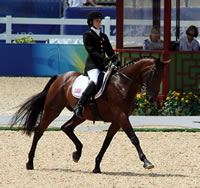“Practice the half-pass like in the Prix St. Georges test–half-pass to the centerline, flying change and half-pass back,” coach Missy Ransehousen’s voice rings across the quiet indoor arena. For the rider, reigning U.S. para-equestrian champion Becca Hart, asking for the half-pass can be a challenge.

Becca was born with familial spastic paraplegia, a condition that weakens muscles and causes lack of lower-body control. It makes walking awkward and balance occasionally precarious because of muscle spasms, never mind the difficulty it adds to riding, mucking stalls, cleaning water buckets and doing the other duties of a working student. But she does all that without a second thought.
In the April 2009 issue of Practical Horseman, we follow Becca through a typical day at the barn. She discusses the challenges she overcame to compete at the 2008 Paralympics in Hong Kong and her recent move up to competing in Prix St. Georges against able-bodied riders.
FEI (International Equestrian Federation) has written tests for each level of para-equestrian competition. While the tests are different than U.S. Equestrian Federation (USEF) dressage tests, the movements included make them roughly comparable to the following USEF levels:
- Grades Ia and Ib are equivalent to Intro Level.
- Grade II is equivalent to Training Level.
- Grade III is equivalent to First Level.
- Grade IV is equivalent to Third Level.
Para-equestrian riders can compete in open shows and can use special equipment or compensating aides (a whip in each hand, for example) as allowed by their “dispensation certificate” from the USEF. At open shows, riders with disabilities can choose to ride the standard USEF tests in able-bodied divisions, ride their FEI para-equestrian test as a test of choice, or do both.
Read more of Becca Hart’s story in the April 2009 issue of Practical Horseman magazine.










